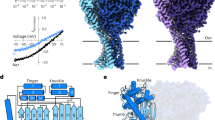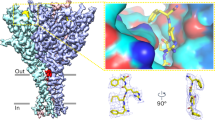Abstract
Neurotransmitters modulate the activity of ion channels through a variety of second messengers, including cyclic AMP1–4, cyclic GMP5,6 and the products of phosphatidylinositol breakdown7–9. Little is known about how different transmitters acting through different second-messenger systems interact within a cell to regulate single ion channels. We here describe the reciprocal actions of serotonin and the molluscan neuropeptide, FMRFamide10, on individual K+ channels in Aplysia sensory neurons. In these cells, serotonin causes prolonged all-or-none closure of a class of background conductance K+ channels (the S channels)11 through cAMP-dependent protein phosphorylation12–14. Using single-channel recording, we have found that FMRFamide produces two actions on the S channels; it increases the probablity of opening of the S channels via a cAMP-independent second-messenger system and it reverses the closures of S channels produced by serotonin or cAMP.
This is a preview of subscription content, access via your institution
Access options
Subscribe to this journal
Receive 51 print issues and online access
$199.00 per year
only $3.90 per issue
Buy this article
- Purchase on Springer Link
- Instant access to full article PDF
Prices may be subject to local taxes which are calculated during checkout
Similar content being viewed by others
References
Siegelbaum, S. A. & Tsien, R. W. Trends Neurosci. 6, 307–313 (1983).
Kennedy, M. A. Rev. Neurosci. 6, 493–525 (1983).
Nestler, E. J. & Greengard, P. Nature 305, 583–588 (1983).
Levitan, I. J. Membrane Biol. 87, 177–190 (1985).
Dascal, N., Landau, E. M. & Lass, Y. J. Physiol., Lond. 352, 551–574 (1984).
Paupardin-Tritsch, D., Hammond, C. & Gerschenfeld, H. M. Soc. Neurosci. Abstr. 11, 466 (1985).
Berridge, M. J. & Irvine, R. F. Nature 312, 315–321 (1984).
Nishizuka, Y. Nature 308, 693–698 (1984).
Oron, Y., Dascal, N., Nadler, E. & Lupu, M. Nature 313, 141–143 (1985).
Price, D. A. & Greenberg, M. J. Science 197, 670–671 (1977).
Siegelbaum, S. A., Camardo, J. S. & Kandel, E. R. Nature 299, 4132–417 (1982).
Castellucci, V. F. et al. Proc. natn. Acad. Sci. U.S.A. 77, 7492–7496 (1980).
Castellucci, V. F., Nairn, A. C., Greengard, P., Schwartz, J. H. & Kandel, E. R. J. Neurosci. 2, 1673–1681 (1982).
Shuster, M. J., Camardo, J. S., Siegelbaum, S. A. & Kandel, E. R. Nature 313, 392–395 (1985).
Klein, M. & Kandel, E. R. Proc. natn. Acad. Sci. U.S.A. 77, 6912–6916 (1980).
Abrams, T. W., Castellucci, V. F., Camardo, J. S., Kandel, E. R. & Lloyd, P. E. Proc. natn. Acad. Sci. U.S.A. 81, 7956–7960 (1984).
Belardetti, F., Abrams, T. W., Castellucci, V. F., Kandel, E. R. & Siegelbaum, S. A. Soc. Neurosci. Abstr. 12, 766 (1986).
Ocorr, K. A. & Byrne, J. H. Neurosci. Lett. 55, 113–118 (1985).
Erxleben, C., Brezina, V. & Eckert, R. Soc. Neurosci. Abstr. 11, 170 (1985).
Brezina, V., Erxleben, C. & Eckert, R. Biophys. J. 47, 435a (1985).
Kretz, R., Shapiro, E. & Kandel, E. R. J. Neurophysiol. 55, 113–130 (1986).
Ocorr, K. A., Tabata, M. & Byrne, J. H. Soc. Neurosci. Abstr. 11, 481 (1985).
Walters, E. T., Byrne, J. H., Carew, T. J. & Kandel, E. R. J. Neurophysiol. 50, 1543–1559 (1983).
Rayport, S. & Schacher, S. J. Neurosci. 6, 759–763 (1985).
Hodgkin, A. L. & Katz, B. J. Physiol., Lond. 208, 37–77 (1949).
Patlak, J. & Horn, R. J. gen. Physiol. 79, 333–351 (1982).
Brezina, V., Eckert, R. & Erxleben, C. J. Physiol., Lond. (in the press).
Author information
Authors and Affiliations
Rights and permissions
About this article
Cite this article
Belardetti, F., Kandel, E. & Siegelbaum, S. Neuronal inhibition by the peptide FMRFamide involves opening of S K+ channels. Nature 325, 153–156 (1987). https://doi.org/10.1038/325153a0
Received:
Accepted:
Issue Date:
DOI: https://doi.org/10.1038/325153a0
This article is cited by
-
The neuronal background K2P channels: focus on TREK1
Nature Reviews Neuroscience (2007)
-
Actions of general anaesthetics and arachidonic acid pathway inhibitors on K+ currents activated by volatile anaesthetics and FMRFamide in molluscan neurones
British Journal of Pharmacology (1998)
-
Modulation of ion currents and regulation of transmitter release in short-term synaptic plasticity: The rise and fall of the action potential
Invertebrate Neuroscience (1995)
-
Are stretch-sensitive channels in molluscan cells and elsewhere physiological mechanotransducers?
Experientia (1992)
-
Dual regulation of M current in gastric smooth muscle cells: β-adrenergic-muscarinic antagonism
Pflügers Archiv (1990)
Comments
By submitting a comment you agree to abide by our Terms and Community Guidelines. If you find something abusive or that does not comply with our terms or guidelines please flag it as inappropriate.



